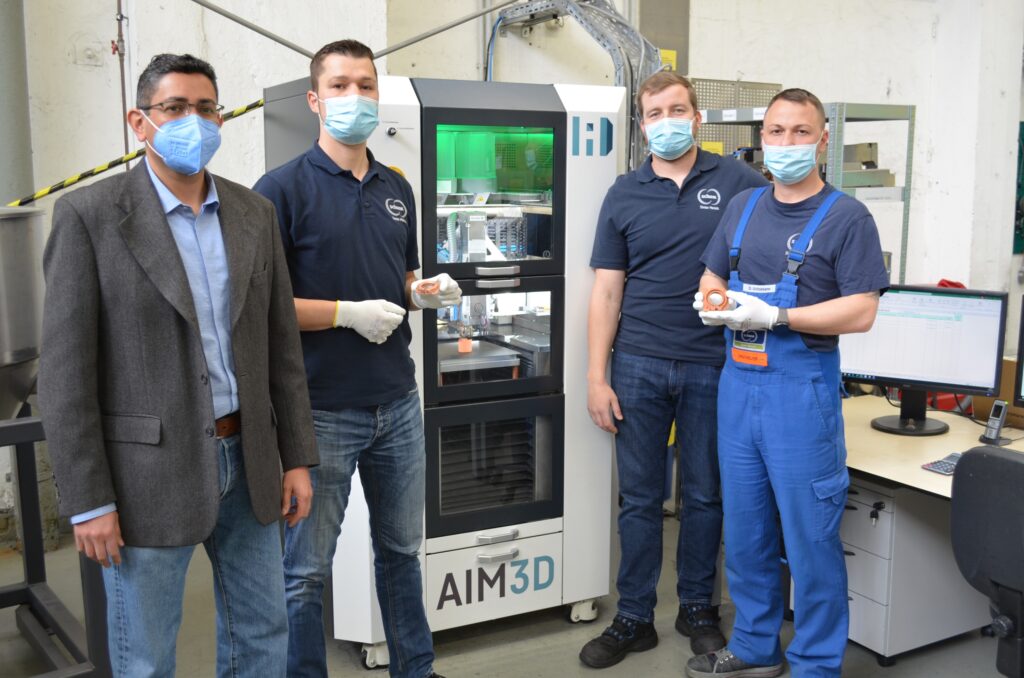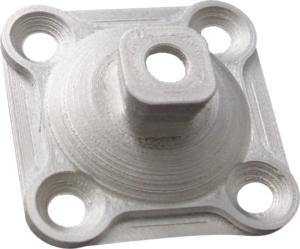AIM3D, a developer of a unique metal and ceramics 3D printing technology, has just secured further funding from 3D printing investor HZG Group and the High-Tech Gründerfonds (HTGF), who backed the Rockstock, Germany startup in 2021. AIM3D will use the money to support the launch of its ExAM 510 3D printer and develop software for the machine.
With a 510 x 510 x 410 mm build volume and weighing 3,500 kg, the ExAM 510 is a granulate material extrusion 3D printer meant to reliably process granulate using the firm’s AIM3D CEM E-1 extruder. AIM3D’s composite extrusion modeling (CEM) process is bound metal 3D printing approach that combines plastic pellets with metal. After printing, the plastic is melted, resulting in a green part. The plastic is debound before the component is sintered in a furnace, leaving a dense metal or ceramic part. The team says that they have better control over shrinkage and residual stresses than with other processes.
“With the ExAM 510, we are now on the home stretch. The feedback from our beta customers will be considered in the final series production later this year. With the support from our existing investors, we can, at the same time, take the sales pipeline to the next level and expand our own machine park to rapidly demonstrate our technological capabilities based on specific customer needs,” AIM3D CTO Clemens Lieberwirth stated.
CEM could compete with bound metal filament or with binder jet to create relatively inexpensive metal parts. For spares and low-cost metal parts, such an approach may very well find some great applications. The same process can also work with cemented carbide, ceramics like aluminum oxide and zirconium oxide, as well as copper, 6061 aluminum, Ti64 titanium and tungsten. The printer allows for the use of metal injection molding (MIM) powders and standard granulate, keeping part costs low.
You can also just use the machine for 3D printing plastic pellets, which have a lower cost than filament. In that case, you can use it with TPU, ABS, PA, PP and even materials with up to 60% GF and CF reinforcement in them. Similar to systems from 3NTR and others, AIM3D wants its printers to be workhorse machines for the shop floor. Additionally, for some metal and ceramic parts, it could be a cost-effective solution, as well.
The build chamber has a temperature of up to 275 °C while the CEM extruders can get up to 400 °C, just shy of PEEK 3D printing territory, although some similar materials may be possible. The company has also tried to patent its voxelfill process where infill chambers can be filled with material to reinforce parts.
“With respect to the combination of size and chamber temperature, AIM3D is launching an unrivaled 3D printer. In addition to the established applications using plastics, there lies great market potential in the processing of high-performance polymers,” said HZG Group CTO Dr. Florian Bechmann.
AIM3D has in and of itself an interesting proposition as a heavy-duty factory 3D printer. By adding the ability to process high-fiber loaded materials, it gets even closer to some manufacturing cases. With comfortable PEEK processing, it would have another business it could aspire to serve, but even without it the PP, PA and PPA filled segment is last growing in 3D printing. Then they also have a less detailed, less fine part but oh so cheap bound metal and binder jet alternative as well. There are a lot of potential markets for this machine and a lot of applications.
My only gripe would be that they have too many options currently. If they were going for the ultimate filled composite material extrusion system then PAEK processability would be something that is paramount. Meanwhile if they were only going for the binder jet alternative they would focus on more metals and fewer plastics. I think that given the huge amount of choice it will be hard for these guys to find the right customers and right successes. On the whole however this is an exciting system with a lot of potential. In rough, large binder jet type parts the potential is in and of itself huge. If they can make their technology work well for these parts then they could have a bright future on their hands.
Subscribe to Our Email Newsletter
Stay up-to-date on all the latest news from the 3D printing industry and receive information and offers from third party vendors.
You May Also Like
New Report: Semiconductor Industry to See $1.4B in 3D Printing Revenues by 2032
“The semiconductor sector has become the most strategically significant area of global industry.” Truer words are hard to come by when it comes to the modern world, and they are...
Will Photonic-Crystal Lasers Revolutionize 3D Printing?
Powder bed fusion (PBF) for metals and polymers predominantly utilizes lasers as the primary heat source. Some directed energy deposition (DED) technologies also employ lasers, while various vat polymerization methods...
3D Printing Unpeeled: Orbex Investment, IndoMIM and HP, Ultrasonic Waves
INDO-MIM has bought three HP Metal Jet S100 printers, operating two in India and one in Texas. This is a win for HP because the company has deep experience in...
3D Printing Webinar and Event Roundup: April 21, 2024
It’s another busy week of webinars and events, starting with Hannover Messe in Germany and continuing with Metalcasting Congress, Chinaplas, TechBlick’s Innovation Festival, and more. Stratasys continues its advanced training...

































